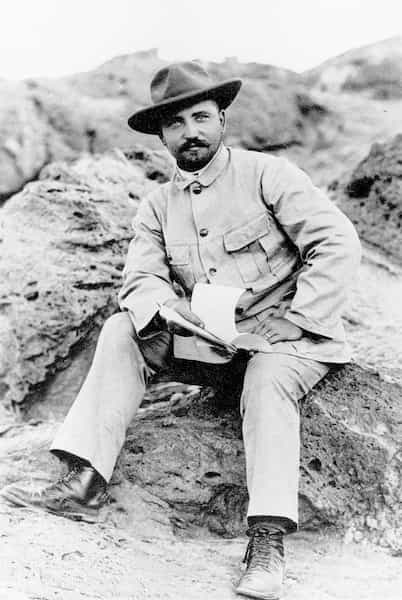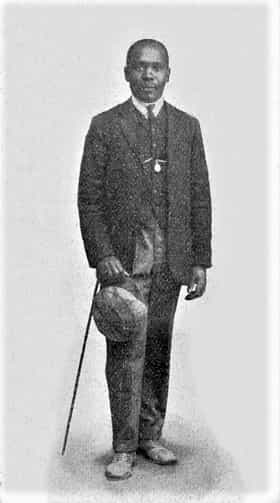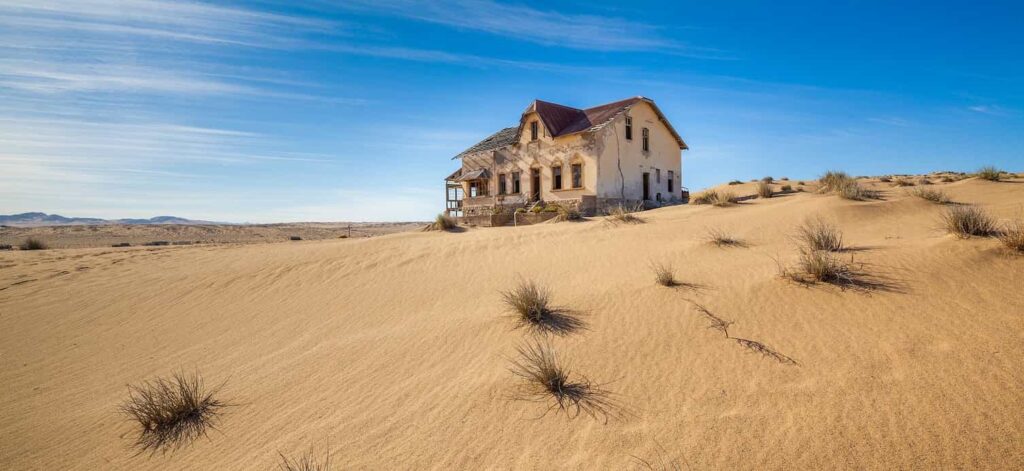Kolmanskop – A Ghost Town in the Namibian desert
Introduction
Kolmanskop, located in the Namib Desert of Namibia, was for a short period a bustling diamond mining town that attracted prospectors and their families from mostly Germany. From an economic and colonial point of view, the town thrived for a few decades before World War 1. Today, Kolmanskop is a ghost town, with its once-grand buildings now empty and left to the elements of the desert.
A short history of Kolmanskop’s rise and fall.
Kolmanskop was founded in 1908 after a worker named Zacharias Lewala found a diamond in the area while working on the railway line. Using the word “worker” might be misplaced in this context. The railroad, an important project in colonial Germany’s expansion plans, was built by slave labor. After 1908, it is possible that the workers at Kolmanskop were free and that they were treated reasonably well. It is said that the number of diamonds was such that one could go out in the moonlight and simply pick them up from the desert sand.
After Zacharias’ superior August Stauch and his associate Sönke Nissen had secured their ownership of the area, the news of the discovery quickly spread. Prospectors flocked to the area, hoping to strike it rich, and the town grew rapidly. The German authorities swiftly closed off the whole southwest part of the country in a so-called Sperrgebiet, Prohibited area. After a short period, Kolmanskop had grown into a new and very modern village with everything a demanding citizen could hope for.
However, the boom was short-lived. After the outbreak of World War I, diamond prices dropped, and many of the German prospectors and workers left Kolmanskop to fight in the war. Namibia was a German colony until 1915 when the South African army invaded the country and defeated the Germans. After the first world war, Namibia was incorporated as a part of the Union of South Africa under the name, South West Africa.
So, the Germans were gone but by that time, the town’s population had already begun to decline. In 1928 the richest diamond field ever known was found near Orange river, some 180 miles to the south. Many of the workers and managers just up and left. In Kolmanskop the mining continued on a smaller scale until 1956 when the town was finally completely abandoned.
In its golden years, the town was a proud host of a hospital with all the latest equipment. There was also a ballroom, a school, a sports hall, an ice factory, and even a small theater where invited theatre companies from Europe performed.
Something about the colored “worker” Zacharias Lewala and his boss August Stauch.
Zacharias Lewala, a railway worker, is credited with discovering the first diamond in the area. In 1908, while shoveling sand off the tracks, he noticed a shiny stone and picked it up. Unaware of what it was, he went to the railway inspector, August Stauch, and handed it over with the words:
– Look here Mister, Moy Klip (Nice stone…)
The supervisor suspected the stone to be a diamond and if so, he knew what to do with it. He associated himself with his friend and co-entrepreneur Sönke Nissen in Lüderitz a few miles west, on the coast. The two claimed a 75 km2 area around Kolmanskop where the diamond had been found. Only after that, they reported the finding to the German colonial authorities.
August Stauch then established the Deutsche Diamanten Gesellschaft (German Diamond Company) and he was instrumental in the development of Kolmanskop. He built up the town. That is, he used underpaid and abused local labor to construct the buildings and equip the mining facility. The local population of Herero and Nama, were at this point just a fraction of their previous numbers since most of them had been slaughtered by the Germans in the Herero and Nama genocide between 1904 and 1908.
And to label Zacharias Lewala a railway worker might be an overstatement. Although he actually single handed founded the mining industry in Kolmanskop, he was probably more of a slave than an actual employee. Read more about the concentration camps in Namibia here.
- August Stauch who was knowledgeable about industrial development became a very rich man.
- Zacharia Lewala is said to have been given a horse, but that is unconfirmed. We also don’t know anything about his endeavors after 1908.
What happened after 1956?
After 1956, Kolmanskop remained abandoned for many years, with only occasional visits from researchers and photographers interested in the town’s history. The buildings continued to deteriorate as the years passed, and a lot of houses were damaged by strong winds and shifting sands.
In the 1980s, however, there was renewed interest in Kolmanskop, and efforts were made to preserve the remaining buildings and artifacts. Also in 1980, the town was declared a national monument. Since then, restoration work has been ongoing.
Today, visitors can tour the town and see the restored buildings and artifacts, including the old post office, hospital, and school. Some buildings have been partially restored, while others have been left in a state of “arrested decay,” preserving their historical value while allowing visitors to see the effects of time and the desert environment. Read about how to get to Kolmanskop here.
I should mention that this isn’t the only abandoned mining facility in the deserts of Namibia. There are also abandoned towns that are not from the mining industry. Any of those can be just as spooky as Kolmanskop.
Paranormal Activity and Haunted Sites in Kolmanskop
Many visitors to the old town report unusual sensations and events. That includes the sound of footsteps and voices when no one else is present, doors that open and close on their own, and ghostly apparitions that seem to disappear into thin air. Some visitors report feeling cold spots, and sudden changes in temperature.
While these experiences have been reported throughout the town, there are certain locations that are claimed to be particularly haunted:
- The hospital – Visitors to the hospital have reported feeling a sense of unease, as well as hearing the sound of footsteps and doors opening and closing. Some have even reported seeing the ghostly apparition of a nurse walking the hallways.
- The theater – The theater is said to be haunted by the ghost of a former actor or performer, who has been seen walking across the stage or sitting in the audience.
- The power station – The power station is supposedly one of the most haunted sites in Kolmanskop, with many visitors reporting feeling a sense of dread or fear when they enter the building. Some have reported seeing the ghostly figure of a man walking through the building, while others have heard the sound of machinery and tools being used, even though the power station has been abandoned for decades.
- The old houses – Some of the old residential houses in Kolmanskop are also haunted, with visitors reporting strange noises, moving objects, and other unexplained phenomena… Or the ghostly apparition of former residents sitting or standing in the rooms.
Concrete examples told by visitors to the custodians of the site:
- A group of visitors was walking down one of the hallways inside the hospital when they suddenly saw a woman dressed in a white uniform walking toward them. The woman seemed to be a nurse, and she was walking decisively as if she was on her way to attend to a patient. The party was startled by her sudden appearance. They were the only ones there and hadn’t heard anyone approaching. They tried to move out of the way to let the nurse pass, but as she got closer, she suddenly disappeared into thin air.
- A man from the US was walking across the stage of the theater when he suddenly saw a woman in a long dress walking towards him. The woman wore clothes from the early 1900s. The man froze in place, watching as she walked across the stage and then vanished into thin air.
- The powerhouse is often troubled by presences. Very often noises are heard in the early morning. Sounds of tools against metal as if someone was working there. In 2016 a group of visitors from Italy, suddenly heard a loud banging noise, from one of the rooms in the powerhouse building. They approached to see what it was. A tall figure was standing in the doorway. It was a man, dressed in clothing from the early 20th century. The worker was facing away from the group and was making the loud banging noise by hitting a pipe against the wall. He seemed unaware of their presence, but then suddenly he turned around and looked directly at the group. They were quite shocked by the man’s sudden and hasty movement, and they quickly backed away from the room.
Scientific studies on Kolmanskop ghost town.
One study was conducted by the Cape Town Society for Paranormal Research in 2009. The team used thermal imaging cameras, electromagnetic field detectors (EMF), and digital voice recorders (EVP). They had some interesting results, but nothing conclusive. The EVPs included the sounds of footsteps.
On March 29, 2011, The Sy Fy television show, Destination Truth aired with an investigation of the site. They used normal paranormal equipment such as EVPs, EMFs, etc. Although claiming to have encountered strange and troubling phenomena, nothing really comes out of it. Just as often is the case.
There was a study in 2016 by Gesellschaft für Anomalistik, Freiburg, Germany. They didn’t find any anomalies at all.
So, nothing particular comes forth in the science department. Only the normal scraping EVPs, pantings, and screamings.
Is it haunted or not?
Well, no. It’s probably not, even though I’d very much like it to be. The thing is that the surroundings, the environment is so breathtaking. The whole place with its location in the middle of the sand dunes, and with that same sand literally floating through the town is magical. Together with its disturbing past, and dark history, it just ought to be a paranormal hotspot. If any spot in the world deserves to be haunted, it’s Kolmanskop.
But there isn’t really anything that points to phantoms, or eerie presences. It is just an awesome place to visit. And if Kolmanskop isn’t enough for you, you could check out Pomona, Bogenfels, Elizabeth Bay, Baker’s Bay, or any of the other ghost towns that lay scattered around Namibia’s vast and windswept countryside. Just remember to get your authorizations and permits in order before arriving.
Conclusion:
As much as I would like it to be true, I can’t find any good reasons to believe in the ghosts of Kolmanskop. I have to add one star for the outstanding environment and the fascinating but sad history.

Information if you would like to visit the Kolmanskop Ghost Town.
Opening hours and tickets for 2013.
- 9.30 – 11.00. Adults N$ 130 Children 6-12 N$ 50 Children under the age of 6 Free. This time frame doesn’t give you the authorization to take photos, not even private photos.
- Photo permit N$ 330 This ticket lets you take photos for personal use. As the site is not fenced, with the photo permit, you can arrive and leave when you want. If you come early or stay late, it is recommended to leave the photo permit in sight behind the windscreen for the guards to see.
How to get to Kolmanskop.
- By car. Towards Lüderitz on the B4. 10 kilometers before arriving at the town, turn left.
- By air: There is actually Lüderitz Airport within walking distance from Kolmanskop… If you’re prepared to walk two kilometers on the desert sands. Check the timetable because there might be only two or three flights a week.



